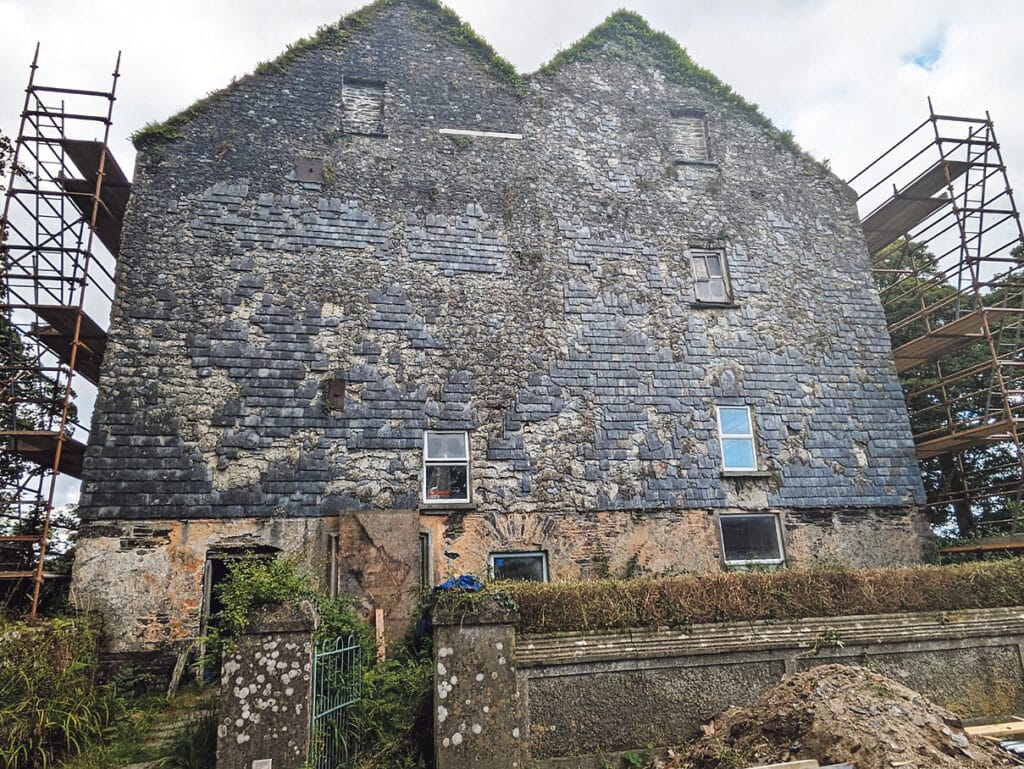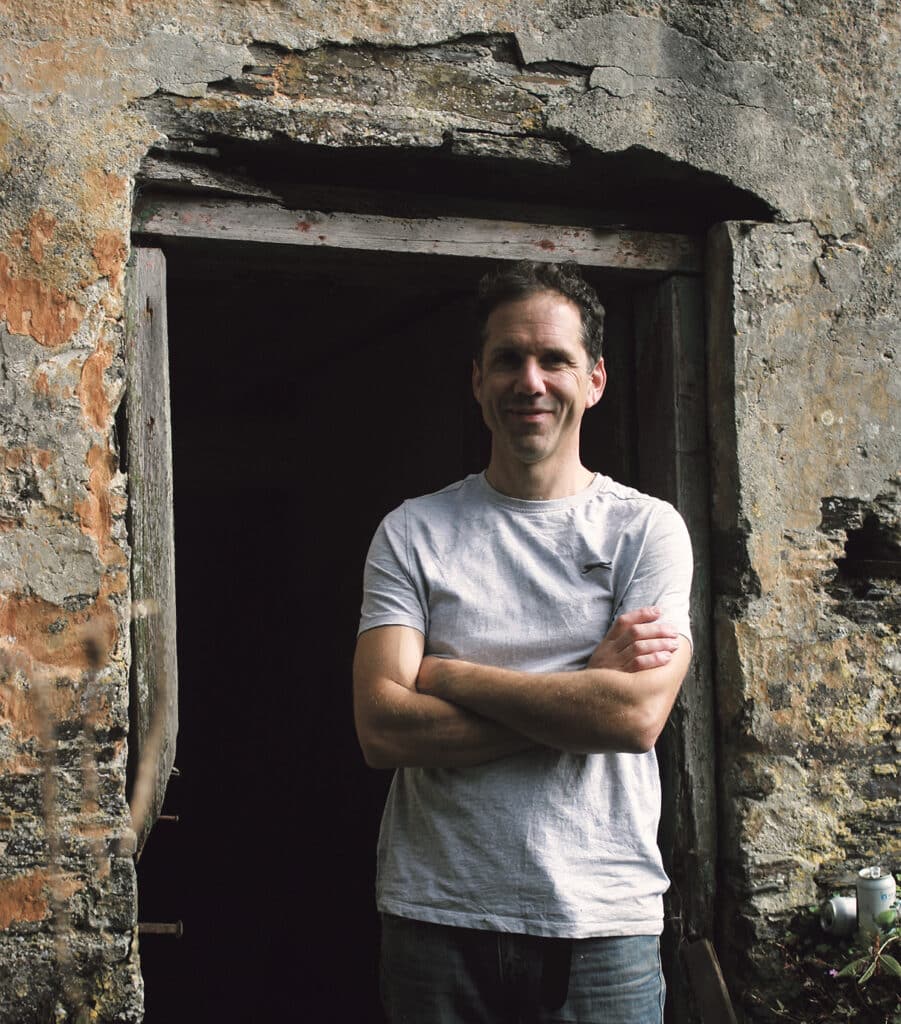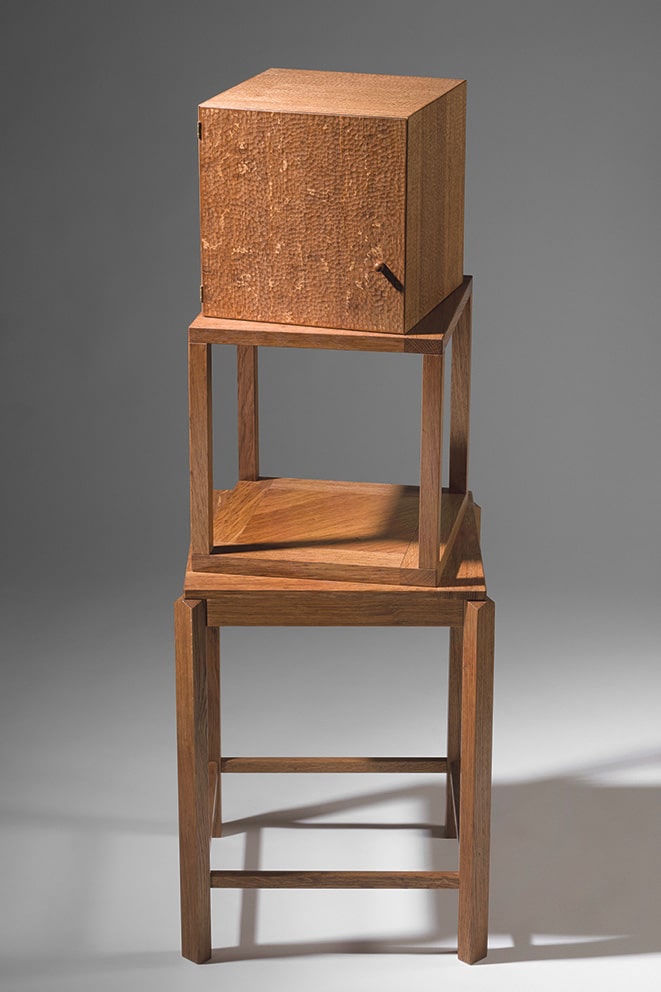A restoration project on the banks of the Arigideen River is breathing new life into what has been identified as the best preserved mill in Cork County – the only one out of 500 in the county still in working order – and one of Ireland’s top five, recognised internationally for the significance of its industrial archaeological heritage. Spearheaded by Joseph O’Leary, the seventh generation of direct descendants of the original mill operators, the Hayes’; the conservation of Castleview Mills is a labour of love that will take great time and effort, but once completed will be a piece of living history. Mary O’Brien takes a walk through the mill and the past with Joe, as he shares his vision for the future of this beautiful old building.
After UCC industrial archaeologist Dr Colin Rynne quantified the historical value of the building, funding was secured 18 months ago under the Community Monuments Fund, which to-date has allowed the mill to be re-roofed and repaired by Silvabuild, a company renowned for its unique timber structures; the lower levels preserved and a new loft built on the third level that may in the future be used as an event or educational space.
“Silvabuild are doing an exceptional job in retaining the character of the building by preserving as much of the original wooden beams and stonework as possible,” shares Joe, who is passionate about maintaining the original features and story that goes with them.
Joe O’Leary grew up just over the hill from Castleview Mills, his father’s homeplace, and spent many hours there as a child, sitting around the fire in his late uncle Pat O’Leary’s kitchen, listening to the historian recount stories of yore.
Originally built by George Hayes in the 1800s, on the site of an older mill, for the purpose of exporting flour to Britain, Castleview Mills is famous as being the site of an eviction attempt in 1886. Interestingly, the failed eviction of Tim Hurley was reported in a number of British newspapers including the Illustrated London News. It’s reported that on word of the planned eviction, a hut was constructed in Clonakilty for the Hurley family, with an estimated crowd of up to two thousand conveying it through the town to Castleview, in a procession with bands playing and banners waving. After erecting the hut in a field near the mill, the crowd gathered to witness the eviction that had Tim Hurley leading a group of 20 to 30 men in defending his home that he shared with his wife and five children. Bailiffs used a makeshift battering ram to attempt getting through the barricade but, after bricks and stones and boiling water were thrown at them by Hurley and his men, they were forced to retreat.
Today the O’Leary family are still in possession of the horn that was blown by a neighbour on the side of the hill to warn of the eviction.
The day after the eviction attempt, Hurley was arrested with packages of dynamite in his pockets, claimed to be for felling trees.
Tim Hurley eventually ended up in Wales where he died from injuries resulting from a purported altercation. He now rests in an unmarked grave under a yew tree in Merthyr Tydfil.
His wife Catherine, a seamstress in Clonakilty also died young and the younger of their ten children were raised by her relatives.
Poignantly, in clearing out the mill, Joe found a draft of a letter written by his grandad when he was younger, asking for legal help, as the rent had gone up and the family were struggling financially. “He talks about how they are honest, decent folk trying to make a living,” shares Joe. “The letter ends by saying they don’t want to end up like Tim Hurley and his family, scattered to the four corners of the earth.”
The mill inside today offers a fascinating glimpse into the past.
Joe points out the old hammer mill used to grind grain. He remembers the roller mill working to grind corn for the cattle when he was growing up.
For Joe, who went on to become a student of mechanical engineering and set up his own engineering business, the mill was a fascinating playground during his childhood. “It was my treehouse,” he laughs. “If my mother only knew!”
Stories of his grandfather, the late Thomas O’Leary, who died in 1958, 20 years before he was born, fuelled Joe’s romantic interest in the past, in particular his own family history in the mill.
“My dad talked about him a lot,” he shares. “He was called ‘the auld boss’ and was a great storyteller. He used to wear a waistcoat around the mill and had a little stubby pencil that he’d pull out when noting the revolutions per minute of the pulleys.”
Working on the mill has offered Joe an insight into the grandfather he never met. “Walking in his footsteps, I feel I’ve gotten to know him and his ways,” he says.
Like his grandson, Thomas O’Leary had an engineering mindset: Without any formal education, in 1918, he replaced the breast shot waterwheel that powered the mill with a turbine system. “The vibrations from the wheel were making cracks in the side wall,” explains Joe, who recalls finding the same equations he studied in applied mechanics on opening his grandfather’s old notebook.
“You do what you need to in order to survive and he had a young family and a mill that was falling apart, so it was a case of needs must I think when it came to doing the repairs himself.”
The turbine hadn’t operated for ten years, give or take, so Joe spent many nights taking it apart and tinkering a few years ago, eventually getting it running again.
Prior to that, when his uncle Pat was still alive, together they got the old lathe going again. “It was pretty dangerous, as it felt like the building was vibrating when it was running,” shares Joe.
The old mill stones and mechanism, which would have moved at 160rpm and was used for grinding the grain into flour and the mechanism for separating the flour are still in place. The mill was operated by Joe’s uncle up until his death in 1995.
One of the miller’s tasks was to dress the stone, chiseling the furrows by hand, a slow and tedious task, which Joe got to experience doing with his uncle.
The bedroom of Joe’s father Jerry, now 81, was less than 20 feet from the mill stones; he remembers waking up to the sound of the stones grinding.
A winnowing machine to separate the chaff from the grain was made by Joe’s grandfather. “I’d love to get it going again just to hear it,” he says nostalgically.
He points out what have been identified by an industrial archaeologist as taper burns on some of the old beams. “These could have been deliberate burn marks created to ward off evil spirits or prevent fire,” explains Joe.
While most of the beams have woodworm, the inner hardwood is perfectly preserved, making conservation easier.
A shelf heaving with old containers and tools remains untouched, giving a sense of people and place.
It’s a building that is perpetually revealing something.
Old stones with bullet marks, salvaged from the scene of the Kilmichael Ambush, were allegedly hidden under the stairs.
An old door still in place holds names inscribed from the past; F Hurley and Pat Hurley, both sons of Tim Hurley.
In the living quarters, Joe winds up the old gramophone, releasing a crackling melody: the ‘Boys of County Armagh’ spills out, transporting the room back to old Ireland.
In the kitchen, a modern fireplace has been ripped out to reveal the original open hearth and the original timbers have been exposed in the ceiling. This is where stories were told around the fire until the early hours of the morning. It’s a scene that Joe would like to recreate; his vision for the space is one that embraces scríochting and wellness.
High up on the third floor under the eaves of the roof are the remains of a kiln, which was used for drying corn. Unusual to have an open fire placed so high in the building but it could possibly have been used to heat the main bedroom underneath.
Outside, the year 1945 carved into one of the stones in the building by Pat O’Leary marks the end of WWII. The year Pat died, 1995, has been carved in a stone alongside by Joe’s brother.
Tools for sharpening blades and cutting slate remain in place.
Almost hidden, an overgrown but serene courtyard garden lies to the side of the mill.
Along the river path, Joe, and his wife Claire, a conservation ranger with the NPWS, have planted native trees by the remnants of an ancient woodland. They hope, in time, to get some animals and manage the land, preserving its biodiversity.
Old workmen’s cottages may be developed for accommodation.
But it’s small steps: The work is currently dependent on funding but the hope is to eventually make the project sustainable so that any income can be ploughed back into the upkeep of the building.
As more of the mill reveals itself, a picture of its future emerges.
“There are so many possibilities…education, wellness retreats, storytelling, events,” says Joe
“Whatever happens here, I’d like to encourage people to be in the moment, switch off their phones for a while and just experience.”
While the mill stones may have stopped turning, it’s a turning of time for this beautiful old building that will add an exciting new chapter to the story of Castleview Mills.
Mill photos by Julie O’Brien







